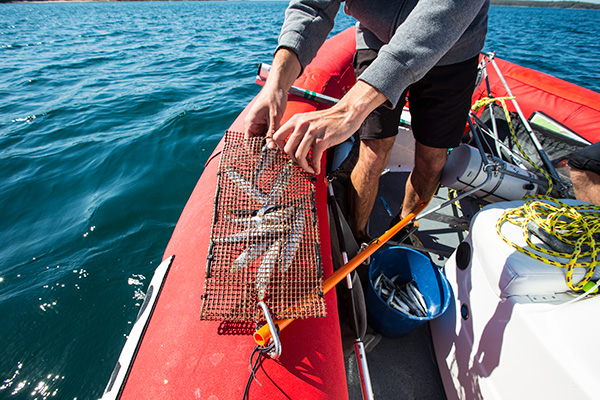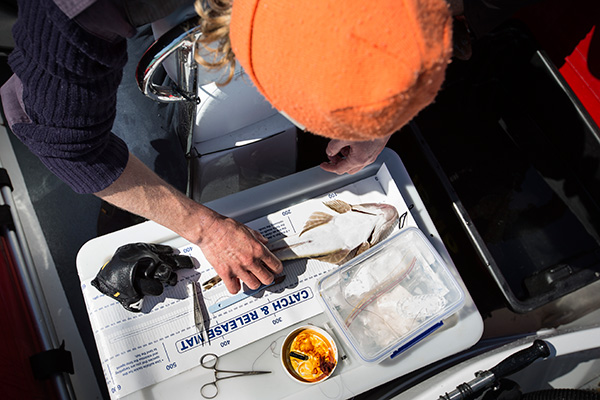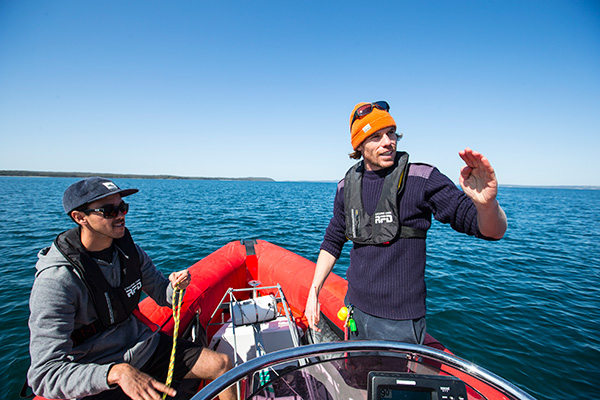November 19, 2014
Fishing for answers: researchers capture picture of fisheries and biodiversity
Innovative underwater research methods to better understand our fisheries resources and conservation.
There could be worse ways to collect scientific data.
Marine Science PhD students Lachlan Fetterplace and Matt Rees from the Institute for Conservation Biology and Environmental Management at UOW’s School of Biological Sciences are motoring across Jervis Bay on a clear spring morning.
The only ripples in the water are from the School’s new 5.5 metre research vessel ‘Maarra’.
Matt and Lachlan are using the idyllic waters of the Jervis Bay Marine Park to carry out research that will further unlock our understanding of the biodiversity and functioning of our rich fish communities. These communities are not only a corner stone of a healthy ecosystem but also provide valuable food stocks and recreational enjoyment for Australians.
Both Lachlan and Matt are keen fisherman and marine conservationists who have turned a hobby and passion into a serious profession, while their social media presence as the Fish Thinkers has garnered a large following of people interested in the vital and beautiful marine world.
Today, the pair, who are under the co-supervision of UOW’s Professor Andy Davis and Dr Nathan Knott from the NSW Department of Primary Industries (DPI), are using state-of-the-art research equipment, enabling the vital insights their research programs provide.
Matt carefully lowers DPI’s high-definition stereo video cameras mounted on a galvanised steel frame into water to survey fish that are associated with seafloor habitats.
A bait of pilchards in a bag attached to the frame draws a range of species such as Snapper, Bream and other reef fish in view of the camera.
“I’m interested in the relationship between fish and their habitat, so looking at how the shape, size and arrangements of habitat influence fish distributions and population numbers,” Matt says.
“Back in the lab we look through the footage and count the species and density of fish we observe. That information will feed into fisheries conservation and marine protected areas by allowing us to predict which habitats and arrangement of habitats are important to protect fish populations.”

Matt Rees fixes a bait bag that will be mounted on the underwater camera frame to attract pelagic fish species.
After the baited underwater video system settles on the bottom it’s GPS location is marked and left to do its work.
“Another part of my research is using these cameras to survey pelagic fish, those that swim in the open water away from the seafloor. We’ve recorded Black Marlin, Yellowtail Kingfish and Bonito, which are often quite interested in checking out the camera system, so we have some remarkable footage.”
Fishermen have long used lures with a clicking or whirring sound to attract game fish. From Matt’s knowledge of these techniques, he hit upon the idea of trialling several of these attractants to increase the effectiveness of the video technique.
“Up to now, these camera systems have only been used to sample fish using bait, but I’m banking on pelagic species using a range of sensors such as sight and sound and not just smell.
“I recorded sounds of two known prey species of larger pelagic fish, the Yellowtail Scad and Slimy Mackerel, and played this through an underwater speaker located above one of the camera systems.
“I found the combination of sound, scent and sight recorded a substantially greater abundance of pelagic fish as compared to the other underwater video stations with only one attractant.
“This discovery, although only a small step, means that we now have a better means of sampling these fish.”
While Matt’s current work concerns pelagic species, a large part of Lachlan’s research involves tagging and tracking movements of species that spend their time in water with a predominantly sandy bottom.
“Sand is a habitat that maybe isn’t as sexy as coral reefs and seagrass so it isn’t studied as often but it’s actually highly productive and the dominate habitat on this part of the coast in this part of NSW,” Lachlan says.
“A lot of the species found in this habitat are targeted by recreational fishers. It’s where species such as the flatheads and whiting are commonly caught.”

Marine science PhD student Lachlan Fetterplace inserts an acoustic tracking device in a flathead from Jervis Bay.
During the course of his project Lachlan will catch upwards of 50 Blue Spot Flathead, to be followed by other species, and implant them each with an acoustic transmitter.
Each fish is sedated in an anaesthetic bath and an acoustic tag is inserted in an incision made in its belly cavity.
“I’ve trained with DPI specialists on this technique and surgery, plus my dad is a vet,” Lachlan says, as he delicately stiches up one of the sedated fish in the boat, now a temporary surgical ward.
He performs the internal tagging quickly and efficiently and the small incision will grow over within two to three days.
The fish is revived and monitored to ensure it’s at full health and finally returned to the water at the exact location it was caught.
Once inserted the acoustic tag will start emitting a signal or ‘ping’ that is picked up by a sophisticated cluster of DPI receivers throughout Jervis Bay, capable of pinpointing the location of the fish to within a few metres. A dispersed array of DPI receivers across Jervis Bay will detect more wide-ranging movements of the fish
In our previous study, we have tracked tagged fish for up to two months, Lachlan says. In this study they are hoping to track their movements for up to two years.
If the fish leaves Jervis Bay, an acoustic gate across the mouth of bay will detected the exit of the tagged fish. Beyond the opening of the bay, the researchers can also take track its movement via the Australian Animal Tagging and monitoring system (AATAMS), a national network of more than 2000 receivers along the Australian coast.
“Over the long term it’ll help us work out which areas in the bay and marine park that they use and for how long. If we are lucky we may even pick up details on where they may be spawning, and if they’re aggregating or migrating.”

Understanding the movement of fish could also be used to more accurately interpret the fish population data.
“Using underwater video I compare areas that commercially fished to those are recreationally fished and those areas that are no-take zones in Marine Protected Areas and look at the differences in these populations.
“If the fish are moving around a great deal the population numbers between the zones might not differ too much. If the fish aren’t moving around then we might expect to see more fish in areas that aren't being fished.
“I’ve got to process hundreds of hours of footage of the fish and the seafloor before I can answer this question. Either way it’s intriguing work that has not yet been attempted.
The work the pair are undertaking will lead to one certain outcome: better data. And better data means better fisheries management and conservation, which contributes to species survival and sustainable enjoyment of a wonderful asset.
“I’m a fisherman too and I love fishing. I want to be able to catch fish into the future and I like learning about fish, fisheries and the outdoors. I think this is valuable research.”